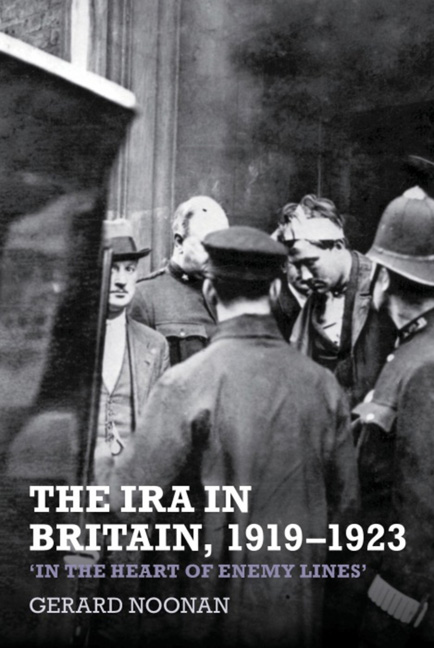Book contents
- Frontmatter
- Contents
- List of Illustrations
- List of Tables
- List of Graphs
- List of Abbreviations
- Acknowledgements
- Introduction
- Prologue
- 1 ‘On a Solid Footing’: Organizing Republicanism in Britain, January 1919–July 1921
- 2 Supplying an Army: Gunrunning in Britain, January 1919–July 1921
- 3 ‘We are doing what you are doing in Ireland’: IRA Operations in Britain, January 1919–July 1921
- 4 Truce, Treaty and Dissension, July 1921–June 1922
- 5 The Civil War, June 1922–May 1923
- 6 Combating the ‘Sinn Fein Movement’ in Britain: The Response of the Authorities, 1919–1923
- Epilogue and Conclusion
- Select Bibliography
- Index
Introduction
- Frontmatter
- Contents
- List of Illustrations
- List of Tables
- List of Graphs
- List of Abbreviations
- Acknowledgements
- Introduction
- Prologue
- 1 ‘On a Solid Footing’: Organizing Republicanism in Britain, January 1919–July 1921
- 2 Supplying an Army: Gunrunning in Britain, January 1919–July 1921
- 3 ‘We are doing what you are doing in Ireland’: IRA Operations in Britain, January 1919–July 1921
- 4 Truce, Treaty and Dissension, July 1921–June 1922
- 5 The Civil War, June 1922–May 1923
- 6 Combating the ‘Sinn Fein Movement’ in Britain: The Response of the Authorities, 1919–1923
- Epilogue and Conclusion
- Select Bibliography
- Index
Summary
This book studies the activities of Irish physical force republican organizations in Britain from the outbreak of the war of independence in 1919 to the conclusion of the civil war in 1923. The Irish Volunteers or Irish Republican Army (IRA) is the main focus of study, though the Irish Republican Brotherhood (IRB) or ‘Fenians’, the Cumann na mBan and Na Fianna Éireann are also accorded attention. Other organizations associated with these physical force groups, such as the Irish Self-Determination League of Great Britain (ISDL) and Sinn Féin, are given consideration as well.
The activities of republicans in Britain during this period are virtually bookended by the escape of Sinn Féin president Eamon de Valera and others from Lincoln prison in February 1919 and by the arrest and deportation to Ireland of over 110 anti-treaty activists in March 1923. In the interim, republicans were involved in a variety of activities, most importantly gunrunning and attacks on property.
Conspiratorial Irish republicanism in Britain was nurtured by the culture of Irish immigrants who settled in England, Scotland and Wales in the nineteenth century. Such immigration is usually associated with the Great Famine of 1845–51. The Irish were already a familiar sight in Britain prior to this, but the repeated destruction of the potato crop precipitated a dramatic increase in emigration to Britain, a trend that was sustained for a long period thereafter by the lack of economic opportunities in Ireland. By 1861, the Irish-born population of Britain numbered 805,717, scattered mainly in urban areas of northern England and Scotland. Thereafter, except for a slight increase in the 1870s, it began to decline until it numbered just under 524,000 at the height of republican activity in Britain in 1921. If second- and third-generation Irish are included, the Irish Catholic population as a whole in Britain probably exceeded 2,000,000 by then. Many native Britons feared and loathed the Irish, distaining their Catholic religion and strange customs. A number of anti-Irish riots occurred in the period from the 1830s to the 1860s. However, most Irish in Britain did not experience such violence. If they did suffer discrimination, it was usually of a more subtle kind, such as difficulties in finding employment.
- Type
- Chapter
- Information
- The IRA in Britain, 1919–1923‘In the Heart of Enemy Lines’, pp. 1 - 6Publisher: Liverpool University PressPrint publication year: 2014



